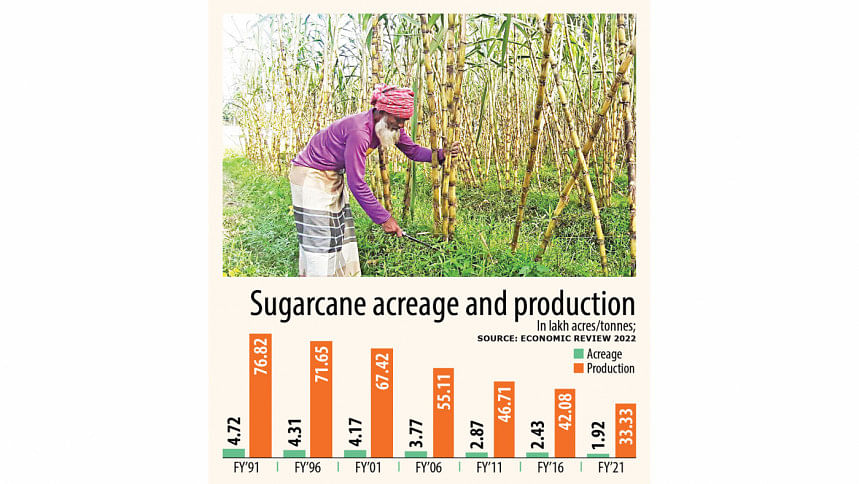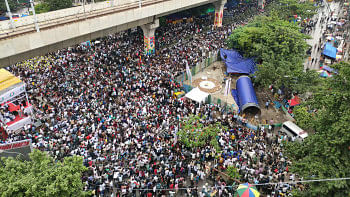Sugarcane production on the decline

Sugarcane production and acreages in Bangladesh have more than halved in the last two decades as farmers find it difficult to generate a steady stream of profit from the crop, official figures showed.
The production stood at 67.42 lakh tonnes in the fiscal year of 2000-01, but it fell to 33.33 lakh tonnes in 2020-21, according to the Bangladesh Economic Review 2022.
During the period, the acreage under cultivation dropped to 1.92 lakh acres from more than 4.17 lakh acres.
In FY21, sugarcane production fell nearly 10 per cent from a year ago. Some 36.83 lakh tonnes of sugarcane were grown in FY2019-20 in 2.13 lakh acres of land.
In Tangail, sugarcane farming has gone down this year from a year ago. As a result, the target set by the Department of Agricultural Extension (DAE) could not be achieved.
According to the DAE in the district, a goal to grow sugarcane on 500 hectares of land was set for the ongoing season with a view to producing 23,600 tonnes of sugar.
However, the crop has been cultivated on 388 hectares of land, according to Nargis Akter, a sub-assistant agriculture officer of the state-run agency in the district.
The crop was cultivated on 422 hectares of land last year, producing 20,256 tonnes of sugarcane.
In the sadar upazila, the DAE had targeted to cultivate sugarcane on 250 hectares of land to produce 11,800 tonnes of the crop. Finally, it has been grown on 160 hectares.
Ziaur Rahman, upazila agriculture officer in Tangail sadar, attributed the fear of floods to the lower cultivation. Farmers cultivated maize, paddy and vegetables in place of sugarcane.
"The yield has, however, improved compared to last year thanks to favourable weather conditions. Farmers are also getting higher prices as demand for sugarcane sticks has increased among consumers," he said.
Sugarcane cultivation is also more profitable than other crops since crops such as oil seeds, spices and lentils, and vegetables can be cultivated alongside it as associated crops, officials say, adding that the cultivation of associated crops can help offset losses partially if sugarcane is damaged by any natural disasters.
During a visit to several sugarcane fields in the sadar and Ghatail upazilas, it was seen that the harvesting of the crop was going on.
Wholesalers from Tangail and adjacent districts were found to be collecting sugarcane sticks from the fields. They will send them to various parts of the country, including Dhaka, through trucks.
Amzad Hossain, a farmer in Silimpur village in Tangail sadar upazila, has cultivated sugarcane on 55 decimals of land this year spending Tk 80,000. He has sold sugarcane worth Tk 1.5 lakh.
"Besides, I have cultivated tomato, potato, and garlic on the same field as associated crops," he said.
In the past, Kader Miah, another farmer in the same area, cultivated Aman paddy on his 14 decimals of land and was able to recoup the farming costs.
He cultivated sugarcane on the same land last year and incurred losses due to floods.
"I cultivated sugarcane this year and made a profit of Tk 15,000," he said.
During a visit to the Dharerbari market in the sadar upazila recently, it was found that a stick of sugarcane is being sold at Tk 20 to Tk 40.
Ershad Miah, a villager, said he had bought eight sticks of sugarcane for his family members at Tk 270.
Several farmers have sought support from the government to give a boost sugarcane cultivation in the area and bring more land under the cultivation of the crop.
"Local sugarcane farmers incurred huge losses due to damages caused by the floods last year but none from the agriculture department came forward to provide us any help," said Jinnat Miah, a farmer in Dhitpur village in the sadar upazila.
He cultivated the crop on three and a half bighas of land last year at a cost of Tk 70,000. But all of his crops were damaged by the floods.
"So, I did not cultivate any sugarcane this year," he said.
Ahsanul Bashar, deputy director of the DAE in Tangail, says sugarcane cultivation has not hit the target in the district as farmers who suffered losses for floods last year did not grow the crop this year.
This year, a couple of new verities of sugarcanes, namely BSRI-41 and 42, were planted in the district alongside the local varieties, he said.
"The agriculture department has given necessary advice to local farmers, including on how to save the crop from any pest attack."
Amid persisting losses, the government in 2020 shut six sugar mills: Setabganj Sugar Mill in Dinajpur, Panchagarh Sugar Mill, Shyampur Sugar Mill in Badarganj upazila of Rangpur, Pabna Sugar Mill, Kushtia Sugar Mill, and Rangpur Sugar Mill.
Currently, nine state-run mills produce sugar by crushing sugarcane.

 For all latest news, follow The Daily Star's Google News channel.
For all latest news, follow The Daily Star's Google News channel. 








Comments